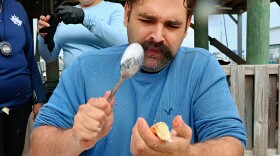When Steven Hoelscher first came across an essay with Langston Hughes' name on it, he says it felt "totally random." Hoelscher, a professor at University of Texas at Austin, was doing research in the archives of an investigative journalist named John L. Spivak.
It was in Spivak's papers that Hoelscher found three pages titled "Foreward From Life," written by Langston Hughes — one of the most celebrated poets of the Harlem Renaissance.
In the short essay, Hughes recounts an experience he had outside Savannah, Ga., in which he encountered a young person escaping from a chain gang. It was the summer of 1927 and Hughes was traveling by car with his friend and fellow writer, Zora Neale Hurston.
"That night, a strange thing happened," Hughes writes. "After sundown, in the evening dusk, as we were nearing the city of Savannah, we noticed a dark figure waving at us frantically from the swamps at the side of the road."
The work had not been seen for decades. Hoelscher eventually figured out that Hughes wrote it as the foreward to the Soviet edition of one of Spivak's books — and it was published only in Russian. The essay appears in Smithsonianmagazine .
Hoelscher says chain gangs would have been a common sight on the roads of Georgia at the time. It was "a system of brutal incarceration that Hughes recognized immediately," Hoelscher explains. "It was no pure luck that most all of the workers were black — and Hughes understood very clearly that this was a form of racial oppression."
Interview Highlights
On Hughes' road trip through the rural South with Zora Neale Hurston
They met up about halfway through the journey for Hughes. ... He read some poems at a commencement at Fisk University in Nashville, and he wanted to learn more about the American South. So he's ... hopping through Louisiana, then Mississippi. He gets off the train in Alabama and who is there on the street but his friend Zora Neale Hurston. So it was a chance meeting ... a wonderful opportunity.
So at that point they decided to travel together. They traveled a lot in Alabama, and then over through Georgia, South Carolina, North Carolina, [and eventually] headed back to New York City. ...
The South was very important in [Hughes'] literary imagination. And so it was important for him to learn about it — and who better to help introduce him to the South than one of the most important folklorists, ethnographers of the American South but Zora Neale Hurston? And by all accounts they had a great time traveling together.
On why the essay was originally published only in Russian
I really had no idea what the essay was — it was not published in any of Spivak's work that I could find. But it was only in reading deep into the archive that I found letters between Spivak and an American journalist living in Russia who thought that Spivak's book that came out in 1932 would be of interest to Soviet readers. And so he wrote to Spivak saying: Well you know what? Langston Hughes is in town — what if we ask if he would write the foreword to this book and we publish it in Russian? And that was sort of the light bulb moment when I figured out how all this fit together.
The book was eventually published in Russian in the Soviet Union — and Hughes wrote the foreword to it. He was living there for a year; he had gone over to the Soviet Union in 1932 to help work on a film about American racism. The film was a bust — it was never completed — but he spent the rest of the year traveling around the Soviet Union, writing.
On how this essay contributes to our understanding of Hughes
He was not an ethnographer — he wasn't like Zora Neale Hurston — but he did listen to people and he wanted to tell their stories to audiences that might not otherwise hear them. ... It's as close as I think we can get to Hughes trying to convey what he heard on that road to Savannah.
Another thing that I think is important is the transnational interest in issues of racism, incarceration that Hughes was working on. ... We don't see in a lot of his work discussions of incarceration. This is something that obviously is very important today and he is one of the first people, I believe, in the literary world to identify it and try to describe it in a way that might motivate people to help change things.
On the relevance of the essay today
Certainly the issue of mass incarceration and its relation to racism — which is at the core of his essay — unfortunately remains with us. And hearing stories of people who are caught in the vice grip of the system feels relevant. There are so many historical actors out there that we just don't know their names, that we don't know their stories — and Hughes has provided us a window into one of those stories.
Copyright 2020 NPR. To see more, visit https://www.npr.org. 9(MDAyMTYyMTU5MDEyOTc4NzE4ODNmYWEwYQ004))









